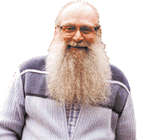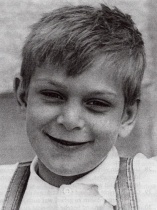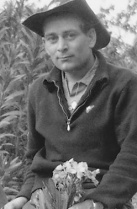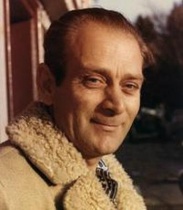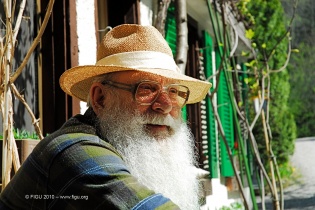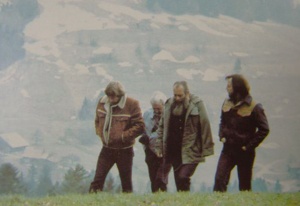Eduard Albert Meier
Introduction
The short biography page offers a brief text about the course of the life of 'Billy' Eduard Albert Meier. Brief biographical extracts can also be found below. [show / hide]
- Biography is an account of someone's life written by someone else. Lengthier biographies are available on the Downloads page under ebooks and 'relevant books by other authors' section.
- Bibliography is a list of the books of a specific author. It can be found under the Short Bibliography, Books, Booklets, Contact Reports, FIGU Bulletins, FIGU Special Bulletins, FIGU Open Letters, Letters from Billy, official FIGU websites and Downloads sections, and several other places.
- Autobiography is an account of a person's life written by that person. Several of Billy's books are autobiographical but most have not been translated from German, see shop.figu.org.
- Interviews are face to face recorded discussion. They are typically informal in a casual setting with Billy, both because we and he himself prefers it that way and its more comfortable. The Interviews with Billy page has some. However Billy has given more formal interviews for television and media in the past, see downloads, ebooks, 'relevant newspaper and magazine articles by other authors' section for a limited selection and other are available on Youtube.
- Memoirs is a historical account or autobiography written from personal knowledge. See Books section and shop.figu.org. Less of these texts have been translated into English because Eduard's written works about humanity have been deemed a higher translation priority divvied among the limited number of translators that exist. If you can read German, enjoy a much richer account of Billy's interesting life.
Who is Billy Meier?
'Billy' Eduard Albert Meier (BEAM) was born in Bülach, Switzerland on the 3rd of February, 1937 and currently resides at the Semjase-Silver-Star-Center (SSSC), Hinterschmidrüti, Switzerland, which he helped build and establish. For over 80 years he has been regularly communicating face to face and telepathically with extraterrestrial human beings and publishing that information. As might be envisaged over such a brilliant quantity of time for a UFO related happening; they've managed to explain everything in full, clarifying the entire story, with extraordinarily interesting facts, opinions and perspectives emerging over the decades. It has all been inciting enough to initiate many thousands of readers from around the world to read into everything and taking interest in his story and life. He's had a life rich with all manner of experiences and accomplishments, in many countries, many of which were difficult, nonetheless important and useful for his evolution and mission in life.
ca.figu.org/billy-s-contacts (external)
Introduction to Billy in English by FIGU Canada.
au.figu.org/beam (external)
Introduction to Billy in English by FIGU Australia.
theyflyblog.com/about-billy (external)
Introduction to Billy in English by Michael Horn in U.S.
Who is Billy Meier (Youtube external link)
Dubhaltagh O Hearcain reads a page from the book ‘And Yet They Fly!’ by Guido Moosbrugger.
| Keyword Index: |
|
|
Light Years by Gary Kinder - One A
A description of Eduard Meier found in a book called Light Years written by Gary Kinder which is all about him and his life; in section One A.
"History first mentions the village of Hinwil, Switzerland in a document dated 745. Thirty miles southeast of Zurich, it nestles in a landscape of rolling green hills pocketed by large islands of forest a hundred feet tall, with the Alps rising in the distance. Hinwil itself, perhaps, would disappoint the tourist looking for the charm of alpine architecture: though chalk-white chalets shuttered in green rise from the village core and scatter among the hills, many stark buildings constructed of concrete have risen in their midst. They resemble not so much the quaint cottages in travel brochures as they do utilitarian apartment buildings erected in the 1950s and '60s in the United States.
But a short distance from the village center, along the street Wihaldenstrasse, stands a three-story farmhouse built a hundred years ago. During the mid-1970s, summer grape vines climbed the sunny south wall of the old house. Flowers filled a stone water trough to the north near the entrance, and small birds fluttered in an aviary built of wood and wire. To the south and east of the house lay a small green field, and to the north and west stood more of the cold, institutional apartment buildings.
The community of Hinwil had acquired the old farm years before and built the surrounding apartments to house senior citizens. Though the farmhouse someday soon would be torn down to make room for more apartments, the community now rented the house for a nominal sum to an unemployed night watchman, Eduard Meier. Meier lived in the house with his Greek wife, Kaliope, nicknamed Popi, and three small children-a girl, Nina, a boy, Atlantis, and the baby, Bashenko. They had been living in the house since December 1973 though they had lived elsewhere in Hinwil for two years.
Meier, a man of thirty-seven, had a sixth-grade education. He was not a very big man, maybe five feet, seven inches tall, but he was thick-chested and strong. His face was handsome, set off by unusual greenish-hazel eyes. According to village records, Meier's professions were "bird breeder, iron layer, night watchman." He held a permit to carry a gun because he had once worked as night security in a factory. [continue reading]
In a former house, a tiny three-room row house contiguous to the Hinwil village museum, Meier had kept a cage out back filled with nearly two hundred birds. He had been employed then as a night guard and, consequently, was often at home during the day. But many people in the neighbourhood avoided talking to Meier because he was "different." He spoke a great deal about Moses and said things other people did not understand. Julios and Erika Kagi knew the Meiers better than other neighbours did because they had a daughter the same age as Nina and the two girls often played together. "He had a terrific fantasy," remembered Erika Kagi, "and I could not agree with his philosophy. But he was not a bad person. He was not even odd; he just had his own ideas and believed whatever he said." Said another neighbor, "Meier lives the way he wants to and does not adapt to anyone else's way of living."
Meier had only one arm. His left arm had been severed just above the elbow in a bus accident in 1965, as he traveled from India, through Turkey, and back to Switzerland. Still, when part of the barn adjacent to the small house collapsed, Julios Kagi saw Meier rebuild the wall alone by holding the boards in place with his shoulder stump while he positioned and pounded nails with his one hand. "He was faster with one hand than other people are with two," recalled Kagi.
Again out of a job, Meier now supported his family on the 700 francs provided him every month by the government for the loss of his arm. To supplement their income, the Meiers kept chickens in the attic of the old farmhouse, and Popi sold eggs to the neighbors. To neighbors living in the apartment buildings overlooking the front door of the farmhouse, Meier seemed to be always home. In a culture that values hard work and conformity, the neighbors saw him as a singular and idle man, often lost in thought, as though the weight of the world rested upon his shoulders, and they began to talk.
Then, on the afternoon of 28 January, 1975, a cold day but warmer than most at that time of the year, Eduard Meier left the farmhouse on his moped, towing a tiny wagon behind him. He wound through the streets of Hinwil, steering with one hand, the empty left sleeve of his leather jacket jerking in the wind. Working his way out of town, he eventually came to a country road, which he followed for a time, then disappeared into the forest of a nature conservancy. A few hours later, he returned to the farmhouse without telling anyone where he had been.
Several days passed, during which the neighbours saw Meier dawdling around the house, seemingly as always without purpose. Then, one afternoon, he again pulled his moped from a storage room, pedalled it down the driveway until the tiny motor kicked over, and rode through the village out into the country. Soon, he was lost from view in another of the islands of forest surrounding Hinwil. When he returned, as before, he told no one where he had been or why he had been there. But the Swiss are observant and curious people, and the neighbours noted his peculiar comings and goings.
Within weeks, Meier was travelling regularly into the forest, guiding his moped with one hand, the tiny wagon behind. Each trip seemed to take him along a new path in a new direction through town and out into the country highways, often for as long as an hour. Later, many of his trips took him into the hills. Sometimes, he would disappear in the early afternoon and not be seen again before supper; other times, he would sneak from the house at one or two in the morning and not return till dawn.
"He had to go away again and again," Popi remembered. "He would come home for five minutes, fix himself a cup of coffee, and hop, he was gone again. It was bad at night. You'd be sleeping peacefully and the kids were quiet in bed. All of a sudden, he would get up, get dressed, and be gone. You know? You think your husband is lying in bed next to you, but he is gone. I did not know anything. All he said was that he was going to work."
As the weeks passed, Meier's journeys through town and into the forests began to occur three, four, even five times a week. And his frequent departures rubbed against the grain of order and routine so conscientiously observed by his neighbours. The more he disappeared, the more they talked.
"The people in the neighbourhood didn't know any thing about what was going on," said Popi, "but they were very curious. They could tell me, to the minute, when he left on his moped and when he came back. It was always the same questions. 'Why did he come home so late?' Sometimes he got up in the middle of the night and left, so they would hear the moped. And when he did this, it was even worse with the people the next day. 'Why did he leave last night?' 'Where did he go?' I would say nothing. I wasn't interested. They are just Schnuriwiiber [gossips]."
On clear nights, neighbours living in the apartment building just above the farmhouse saw Meier standing in the alleyway to the west and watching the sky through binoculars for hours. On nights when he did not leave the house, neighbours to the east saw a light burning on the second floor late into the night.
A week, a month, maybe two months passed, Popi could not remember. Then, one afternoon, as the two of them stood in the small living room on the second floor of the house, her husband handed her photographs.
"What do you think of this?" he asked.
But Popi only stared at the pictures.
"I was shocked," she recalled, "because I saw something completely new, and I did not want to believe that this existed. He said nothing at all. Didn't explain. Not one word." Her husband merely picked up the pictures and left the room, as Popi yelled at him for wasting his time taking pictures when money for the family was so scarce.
Meier next took the photographs to his friend Jakobus Bertschinger, whom he had met while working at the Piatti gravel pit years earlier. Though Jakobus was twelve years younger than Meier, the two men had struck up a lasting friendship. They spent much time together, talking about Meier's experiences during the twelve years he had travelled back and forth through India and the Middle East. But Jakobus, too, seemed confused by the photographs Meier showed to him. He even laughed, but he promised to help his friend in any way he could. With a loan from Jakobus, Meier placed a small classified ad in the German publication Esotera. The ad solicited people interested in forming a group to discuss natural life, logic, and truth-things "metaphysical."
Several more months passed. Through the summer and fall of 1975, the neighbours along Wihaldenstrasse watched Meier continue his frequent trips into the foothills and forests at all times of the day and night. On his little green moped, he often was seen at the edge of the open road, putt-putting along, twenty, maybe twenty-five miles an hour, passed constantly by the much larger and faster automobiles. But then, something new entered Meier's routine: one Saturday afternoon, a half-dozen cars appeared at the farmhouse and remained till late at night.
The neighbours did not understand why people came to see this man. He was poor and handicapped, with an unkempt wife who spoke little of their language. He did not work, and his habits seemed strange. But over the weeks and months, not only did the visitors continue to come, but their numbers increased. In the tiny parlor on the second story, the man with the single arm and unusual hazel eyes spoke to these people for hours. When they left, the neighbours heard Popi screaming at him. For many months, the neighbours watched Meier disappear frequently at odd hours and saw the cars on Saturday afternoons filling the narrow alleyway, running alongside No. 10 Wihaldenstrasse, and spilling onto the streets of Hinwil."
Gary Kinder
Source: Light Years Gary Kinder PDF (external)
Common misconceptions
List of common misconceptions about the FIGU information by subject
Explanation about the broad subject of why
- Billy must take the precaution to not allow the knowledge of how and at what point in time he will depart from all others unexpectedly and unassumingly from the worldly living area, so that an idol would not be made of him, if the dates would come to be known. Its only allowed to be known that he will again, in around 800 years, be the centre point of the FIGU innermost group again, just as this arrangement existed in earlier times at various times and also exists today.[1]
- He does keep in touch with his biological brothers and sisters, with two (Hedi and Berti) of his three sisters who are still alive. His two brothers and one sister (Vreni) are dead.[2]
- Billy is not the sole author nor solely responsible for a significant part of the information, much of it originates from the Plejaren and Plejaren Federation.
Further Reading
Links and navigationFuture ![]() f Mankind
f Mankind
- Eduard Meier, Bio, Why him?
- Interviews, Witnesses
- Spirit Teaching, Introduction
- FIGU, SSSC
- Books, Booklets, His Work, Biog
- Contact Reports, Sfath's, Asket's
- FIGU Bulletins
- FIGU Open Letters, from Billy
- FIGU Special Bulletins
- FIGU Zeitzeichen
- Recent Changes
- Search
- Photo Gallery, Art Gallery
- Overpopulation
- Prophecies and Predictions
- Peaceful Music
- Audio Evidence
- Expert Opinions and Science
- Photographic Evidence
- Physical Evidence
- Earth Event Timeline
- Psyche, Consciousness and Ratio
- Beamships, Atlantis, Planets
- Learning German
- Downloads, Video, Audio
- FIGU terms, Other Authors
- Reincarnation, Human, Brain
- Spirit, Supernatural, Telepathy
- Evolution, Creation, Religion
- Gaiaguys Web, TJResearch
- Telekinesis, Psychotelekinesis
- Unconsciousness, Materialkinesis
- Bigfoot, Easter Island, Pyramids
- Block of Mentality, Placebo
- Contact Statistics, Book Statistics
- External Links, Rare Archives
- Articles by others, Category view
- Community, Polls, External Links
- Site Index, Categories
- WhatLinks, LinkedChanges
- Index, Meier Encyclopedia
- Website statistics
- Random page
- Special pages
- Contributing Content, Roadmap
- Upload file
- How can I help?
- User help
| Contact Report Index | Meier Encyclopaedia |
|---|---|
| n A B C D E F G H I J K L M N O P Q R S T U V W X Y Z | 0-9 A B C D E F G H I J K L M N O P Q R S T U V W X Y Z |
